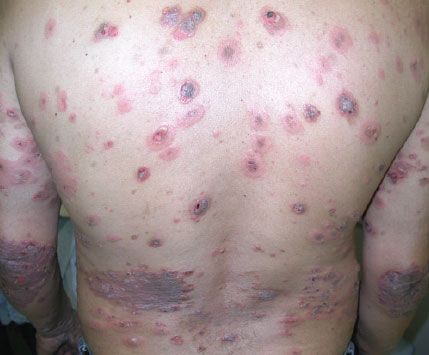A New Look at Age-old Geriatric Ills: Photo Quiz
Many older adults have several related medical problems that have various causes and involve many parts of the body, complicating patient care. This week’s photo quiz offers some common geriatric presentations to test your knowledge.

Question 1:
A man in his 70's came to the ED after 5 days of slurred speech. He had difficulty in swallowing and chewing and had been using his hand to hold his jaw closed. Phonation seemed weak and a bit nasal. The diagnosis was made based on symptoms of bilateral cranial nerve weakness in an older man without other symptoms (almost one-third of cases present in the older population).
NEXT QUESTION »
For the discussion, click here.

Question 2:
This chronic, autoimmune, subepidermal disease mostly affects older persons in the fifth through seventh decades of life; the average age at onset is 65 years. Marked by spontaneous remissions and exacerbations, the condition manifests with tense blisters. It usually starts on the arms and legs and almost never involves the mucous membranes.
NEXT QUESTION »
For the discussion, click here.

Question 3:
An elderly woman with a history of hypertension and coronary arterial disease has a pressure sore on her left heel. She has advanced dementia and cannot provide any useful history. She has a stage 1 decubitus ulcer on her left heel. Her feet feel equally cool. She has weak but palpable distal pulses on the good foot; her distal pulses on the left side are not palpable. You note unilateral petechiae on the dorsum of the left foot but no other petechiae.
NEXT QUESTION »
For the discussion, click here.
For the answer, click here.

Question 4:
A 92-year-old woman presents with sharp abdominal pain of 1 day's duration, accompanied by an episode of emesis. The pain is neither relieved nor exacerbated by food ingestion. She has chronic mild dyspepsia, with a distant history of peptic ulcer disease; congestive heart failure; and chronic obstructive pulmonary disease. An upper GI endoscopy image is shown here.
NEXT QUESTION »
For the discussion, click here.

Question 5:
An 88-year-old woman sought care for a nodule on the anterior surface of her left foreleg that had developed gradually. An exophytic nodule with ulceration and some element of surface hyperkeratosis in a geriatric patient is almost always malignant. A biopsy in this case disclosed a deeply invasive diagnosis.
NEXT QUESTION »
For the discussion, click here.

Question 6:
Nursing staff noted a blue second toe on the right foot of a 77-year-old woman being treated for complications of dementia. She had had aortic problems and atrial fibrillation. Manual separation emphasizes dissemination of irregular purple discoloration onto the sole just proximal to the blue toe. Prominent warty keratosis is seen on the inferior surface of the second toe and keratinous debris on the third toe and in a 1-cm-deep “trench” just before the smaller toes separate.
NEXT QUESTION »
For the discussion, click here.

Question 7:
An 88-year-old man presented with a nonhealing ulcer on his right lower limb. The lesions started as multiple red nodules and became ulcerated and painful. He had extensive necrotic ulceration of his shin, covered by black hemorrhagic crust. A 3-mm punch biopsy showed “benign ulceration”; an arteriogram showed calcification of the profunda femoris and superficial femoral arteries. His condition is most often found with chronic renal disease and secondary hyperparathyroidism.
ANSWER KEY »
For the discussion, click here.
ANSWER KEY:
Question 1. D
Question 2. B
Question 3. C
Question 4. A
Question 5. C
Question 6. C
Question 7. E